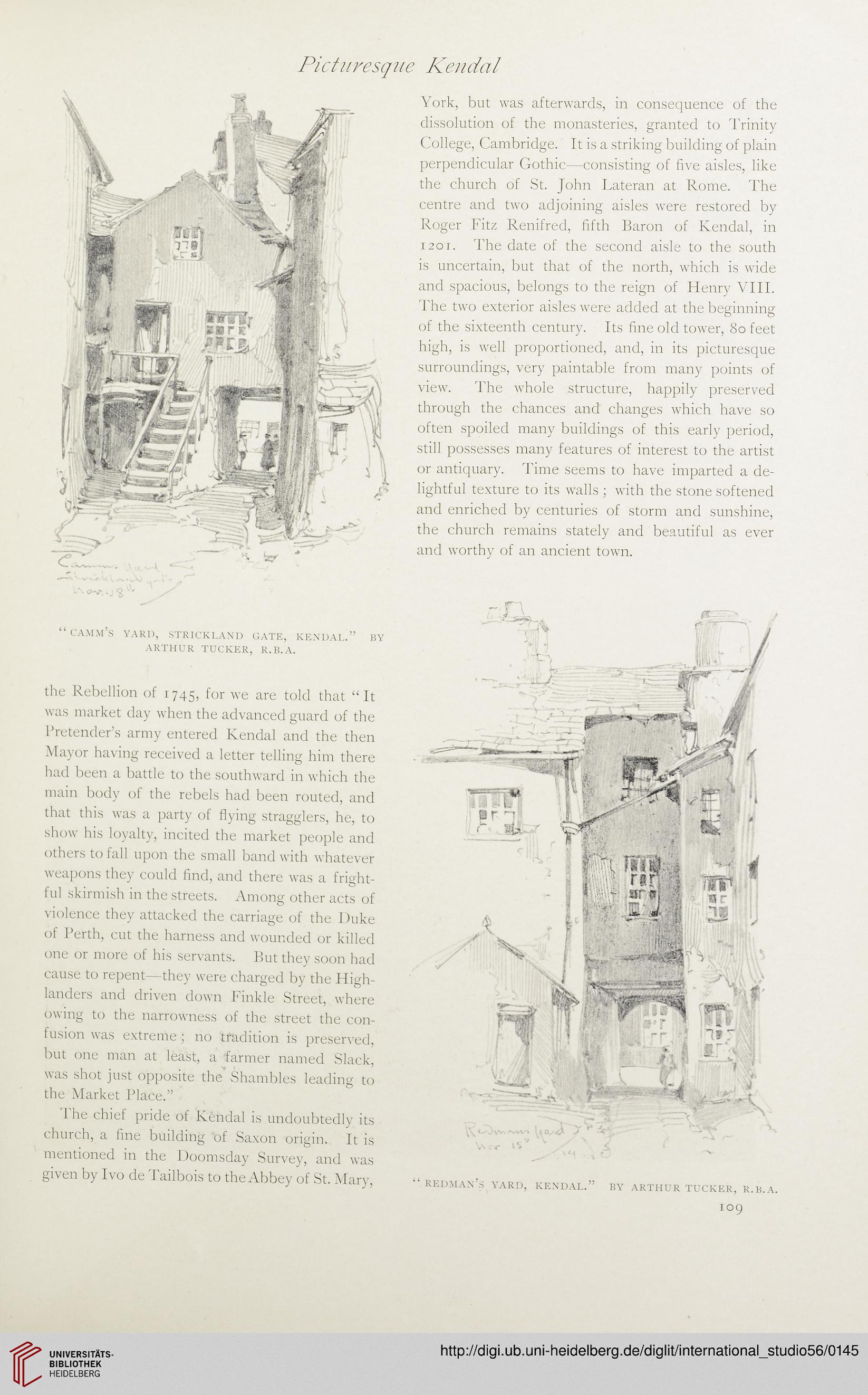Picturesque
-N . j Q "v
“ camm’s
YARD, STRICKLAND GATE, KENDAL.” BY
ARTHUR TUCKER, R.B.A.
the Rebellion of 1745, for we are told that “It
was market day when the advanced guard of the
Pretender’s army entered Kendal and the then
Mayor having received a letter telling him there
had been a battle to the southward in which the
main body of the rebels had been routed, and
that this was a party of flying stragglers, he, to
show his loyalty, incited the market people and
others to fall upon the small band with whatever
weapons they could find, and there was a fright-
ful skirmish in the streets. Among other acts of
violence they attacked the carriage of the Duke
of Perth, cut the harness and wounded or killed
one or more of his servants. But they soon had
cause to repent—they were charged by the High-
landers and driven down Finkle Street, where
owing to the narrowness of the street the con-
fusion was extreme; no tradition is preserved,
but one man at least, a farmer named Slack,
was shot just opposite the' Shambles leading to
the Market Place.”
'khe chief pride of Kendal is undoubtedly its
church, a fine building of Saxon origin. It is
mentioned in the Doomsday Survey, and was
given by Ivo de Tailbois to the Abbey of St. Mary,
Kendal
York, but was afterwards, in consequence of the
dissolution of the monasteries, granted to Trinity
College, Cambridge. It is a striking building of plain
perpendicular Gothic—consisting of five aisles, like
the church of St. John Lateran at Rome. The
centre and two adjoining aisles were restored by
Roger Fitz Renifred, fifth Baron of Kendal, in
1201. The date of the second aisle to the south
is uncertain, but that of the north, which is wide
and spacious, belongs to the reign of Henry VIII.
The two exterior aisles were added at the beginning
of the sixteenth century. Its fine old tower, 80 feet
high, is well proportioned, and, in its picturesque
surroundings, very paintable from many points of
view. The whole structure, happily preserved
through the chances and changes which have so
often spoiled many buildings of this early period,
still possesses many features of interest to the artist
or antiquary. Time seems to have imparted a de-
lightful texture to its walls ; with the stone softened
and enriched by centuries of storm and sunshine,
the church remains stately and beautiful as ever
and worthy of an ancient town.
“ redman’s yard, kendal.” by Arthur tucker, r.b.a.
109
-N . j Q "v
“ camm’s
YARD, STRICKLAND GATE, KENDAL.” BY
ARTHUR TUCKER, R.B.A.
the Rebellion of 1745, for we are told that “It
was market day when the advanced guard of the
Pretender’s army entered Kendal and the then
Mayor having received a letter telling him there
had been a battle to the southward in which the
main body of the rebels had been routed, and
that this was a party of flying stragglers, he, to
show his loyalty, incited the market people and
others to fall upon the small band with whatever
weapons they could find, and there was a fright-
ful skirmish in the streets. Among other acts of
violence they attacked the carriage of the Duke
of Perth, cut the harness and wounded or killed
one or more of his servants. But they soon had
cause to repent—they were charged by the High-
landers and driven down Finkle Street, where
owing to the narrowness of the street the con-
fusion was extreme; no tradition is preserved,
but one man at least, a farmer named Slack,
was shot just opposite the' Shambles leading to
the Market Place.”
'khe chief pride of Kendal is undoubtedly its
church, a fine building of Saxon origin. It is
mentioned in the Doomsday Survey, and was
given by Ivo de Tailbois to the Abbey of St. Mary,
Kendal
York, but was afterwards, in consequence of the
dissolution of the monasteries, granted to Trinity
College, Cambridge. It is a striking building of plain
perpendicular Gothic—consisting of five aisles, like
the church of St. John Lateran at Rome. The
centre and two adjoining aisles were restored by
Roger Fitz Renifred, fifth Baron of Kendal, in
1201. The date of the second aisle to the south
is uncertain, but that of the north, which is wide
and spacious, belongs to the reign of Henry VIII.
The two exterior aisles were added at the beginning
of the sixteenth century. Its fine old tower, 80 feet
high, is well proportioned, and, in its picturesque
surroundings, very paintable from many points of
view. The whole structure, happily preserved
through the chances and changes which have so
often spoiled many buildings of this early period,
still possesses many features of interest to the artist
or antiquary. Time seems to have imparted a de-
lightful texture to its walls ; with the stone softened
and enriched by centuries of storm and sunshine,
the church remains stately and beautiful as ever
and worthy of an ancient town.
“ redman’s yard, kendal.” by Arthur tucker, r.b.a.
109




